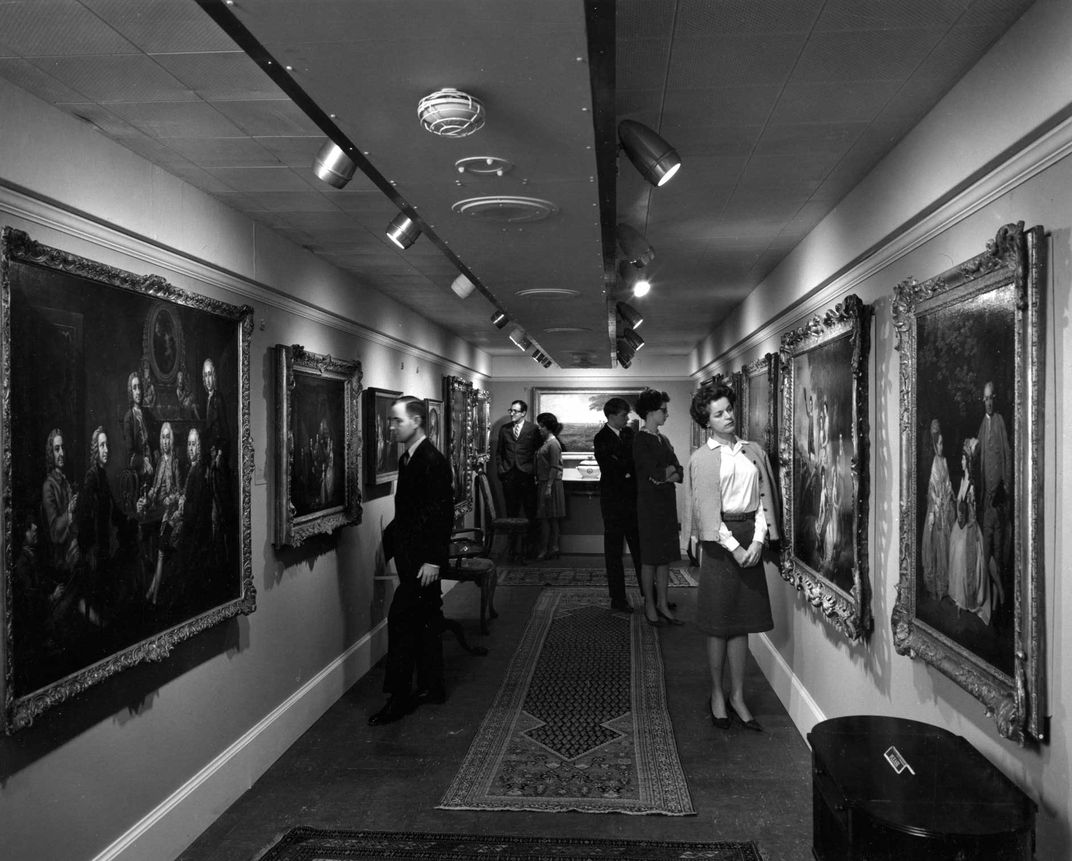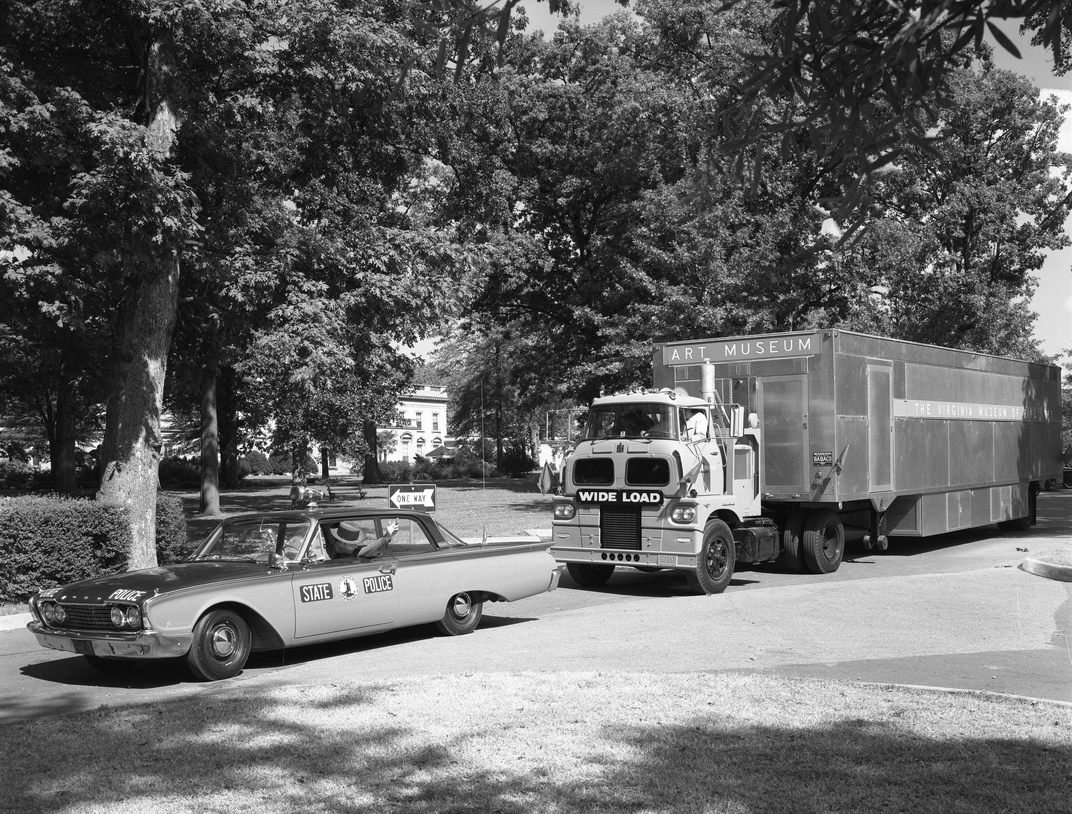Virginia Museum’s Historic Artmobile Will Hit the Road Again
The original artmobile cruised through the state between 1953 and 1994, carrying immensely valuable masterworks in tow
/https://tf-cmsv2-smithsonianmag-media.s3.amazonaws.com/filer/b4/68/b4689d99-51ae-4b85-8d72-97486e95b9be/color-pix_exterior_edc.jpg)
On October 13, 1953, a tractor-trailer carrying 16 artistic masterpieces pulled into the small city of Fredericksburg, Virginia. It was the inaugural stop of the Virginia Museum of Fine Arts’ Artmobile, a traveling mini museum that sought to bring items from the VMFA’s collection to far-flung areas of the state. Wild though it may seem, the walls of the truck were lined with immensely valuable works by 16th- and 17th-century Dutch painters—including an original triptych by Hieronymus Bosch.
Almost 65 years after Artmobile I set off on its first journey, the VMFA has announced plans to re-launch the initiative. According to Mary Lee Clark of the Richmond Times Dispatch, who was first to report the story, the new iteration will be called “VMFA on the Road,” and it is scheduled to hit the road in the fall of 2018.

Jeffery Allison, the VMFA’s Paul Mellon Educator, has mobilized the effort to resurrect the Artmobile. He tells Smithsonian.com that the new-and-improved truck will drive to “K-12 schools, community centers, smaller museums, retirement communities, and community colleges and universities.”
Like its predecessor, the truck will be dispatched to remote and rural corners of Virginia, places where residents cannot easily access the VMFA’s home base in Richmond. While Virginia is home to a number of prominent art museums, Allison point out that “there are giant areas in between that are really not being served.”
“When you get all the way to the tip of Virginia, you're six-and-a-half hours from Richmond,” he says, adding that museum officials decided to bring the Artmobile back to life because they “were looking at ways to ensure that every Virginian has that opportunity to be part of what is essentially their museum.”
Founded by former VMFA director Leslie Cheek Jr., the original artmobile cruised across the state between 1953 and 1994. Over time, the project expanded to include four 34-foot Chevrolet tractor-trailers. Inside the trucks, visitors could find a range of exhibitions, from “Art From the Ancient World,” to “Painters of the Renaissance,” to “Landscape Painting: 1650-1960.” Works by the likes of Rembrandt, Monet and Picasso were mounted onto the walls of the truck and illuminated with soft lighting. “It felt like you were in a gallery,” Allison says.
Though the program proved popular—Clark reports that some 2.5 million people visited the Artmobiles during their heyday—the trucks were ultimately taken out of commission due to conservation concerns. As it turns out, priceless masterworks are not particularly well-suited to bumpy road trips.

VMFA on the Road was founded in the spirit of the original Artmobile, but according to Allison, it will be an “Artmobile 2.0.” The truck, a hulking Volvo with a 53-foot trailer, can expand when parked, allowing it to double in size. The trailer is connected to wi-fi so visitors can enjoy remote-learning sessions with museum educators in Richmond, and many of the truck’s exhibits will be interactive.
The first of the exhibitions will explore the works of participants in the VFMA Visual Arts Fellowship Program, which boasts such illustrious alumni as the late painter Cy Twombly, the photographer Sally Mann and Breaking Bad creator Vince Gilligan. The truck will be divided into three different sections: the first features an introduction to the Artmobile, the second showcases 12 original works by Fellowship artists, and the third is an interactive activity space.
A new storage system that minimizes vibrations will mitigate the conservation issues that caused the initial Artmobile program to shutter. VMFA on the Road will also carry its own generator, allowing officials to control temperatures on the truck. The original Artmobile, by contrast, had to be plugged in at every stop because it did not come equipped with a generator.
The museum has also beefed up the Artmobile’s security with a sophisticated alarm system. The early trucks were wired with alarms, but the Artmobile crew of yesteryear does not appear to have been too anxious about guarding the precious—and pricey—artworks that were stored on the vehicles. In 1963, an Artmobile stalled on its way to Roanoke, and the local TV station WSLS sent a reporter to investigate. Footage of the segment shows a museum official describing the program’s emergency security plan: “We usually notify the state police and the local police in the area that we are broken down, and we’d appreciate that … they will check it out from time to time.”
According to Allison, the new Artmobile “probably” won’t be toting Rembrandts and Monets around Virginia. But the truck will nevertheless feature “significant works of art.” Organizers plan to rotate exhibits every 18 months, and they are currently contemplating a number of themes for future displays. Possible options include African American art, musical instruments in art, and weather and seasons in art.
“We have a wonderful depth in terms of our collection [at the VMFA] now,” Allison says. “It's always growing. We have over 40,000 objects to choose from.”
For Allison, the revival of the Artmobile has personal resonance. As a child growing up in Southwest Virginia, he visited one of the original trucks with his aunt. “[M]y very first experience of the Artmobile was my aunt picking me up and she said, ‘I'm going to take you to an art museum,’” he recalls. “And I got all excited cause I thought I was going on a long trip. She drove about 20 minutes.”
The outing didn’t take him far, but it was transformative. With his eyes opened to a world of art that he had never before experienced, Allison was inspired to pursue his own creative passions. He went on to win a VMFA fellowship for his own photographic work.
Allison said that he hopes the new Artmobile will prompt Virginians to “get very excited and come to Richmond and see the big house.” But if they can’t, that’s OK, too. The Artmobile will bring a taste of the museum’s vast collection to their doorsteps.